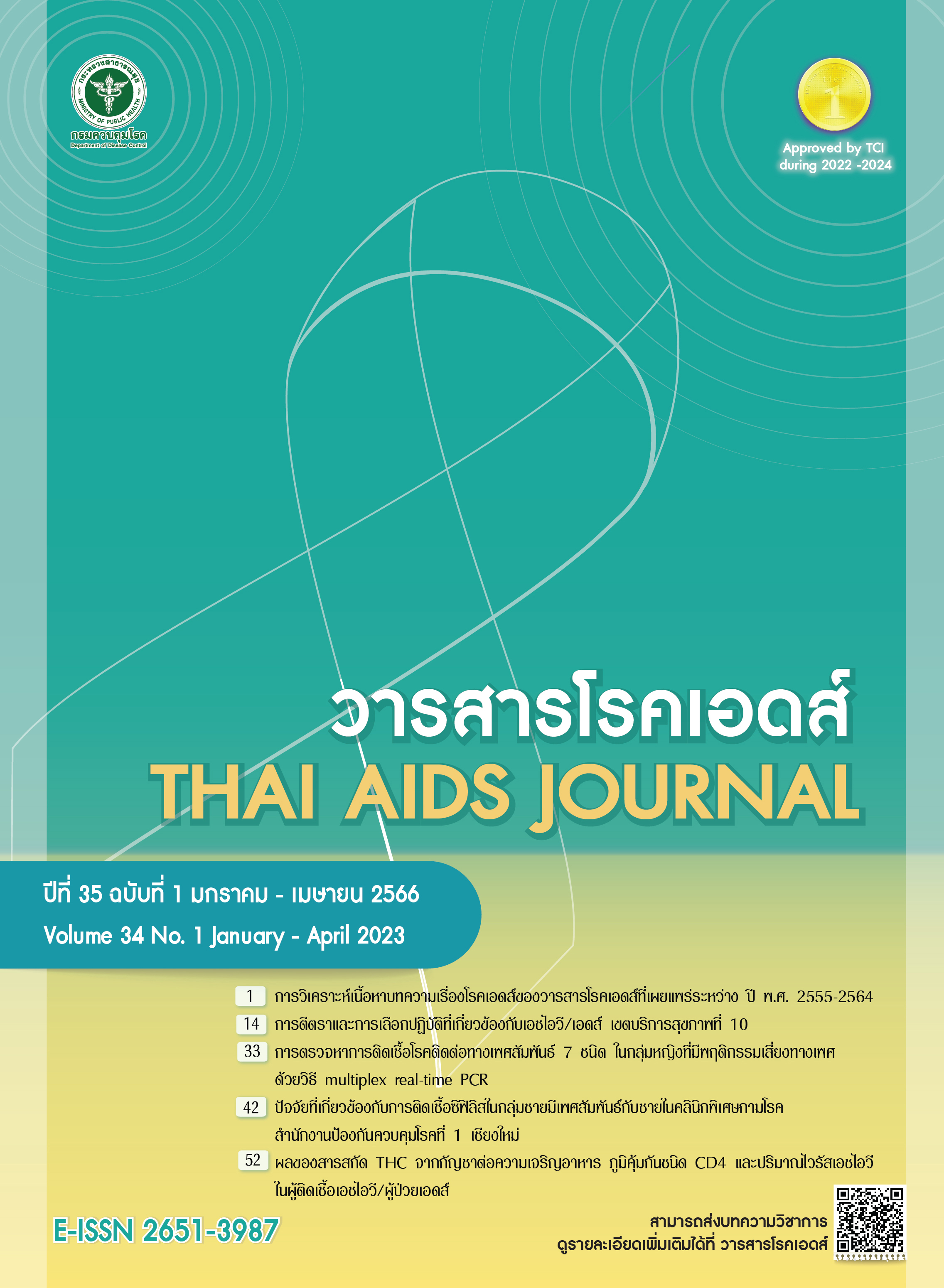การตรวจหาการติดเชื้อโรคติดต่อทางเพศสัมพันธ์ 7 ชนิด ในกลุ่มหญิงที่มีพฤติกรรมเสี่ยงทางเพศ ด้วยวิธี Multiplex Real-Time PCR
DOI:
https://doi.org/10.14456/taj.2023.3คำสำคัญ:
โรคติดต่อทางเพศสัมพันธ์, การตรวจด้วยวิธี multiplex real-time polymerase chain reaction, กลุ่มหญิงที่มีพฤติกรรมเสี่ยงทางเพศบทคัดย่อ
การศึกษานี้เป็นการศึกษาแบบภาคตัดขวาง (cross-sectional study) ระหว่างเดือนมกราคมถึง มิถุนายน พ.ศ.2561 เก็บสิ่งส่งตรวจสารคัดหลั่งจากปากมดลูก (cervical swab) จากผู้ป่วยที่มารับบริการที่คลินิกโรคติดต่อทางเพศสัมพันธ์ กองโรคเอดส์และโรคติดต่อทางเพศสัมพันธ์ จำนวนทั้งหมด 100 ราย แบ่งเป็นกลุ่มหญิงทั่วไป จำนวน 50 ราย และพนักงานบริการหญิง จำนวน 50 ราย วัตถุประสงค์ของการศึกษานี้
เพื่อเปรียบเทียบอัตราการติดเชื้อโรคติดต่อทางเพศสัมพันธ์ 7 ชนิด ได้แก่ Chlamydia trachomatis (CT), Neisseria gonorrhoeae (NG), Mycoplasma genitalium (MG), Mycoplasma hominis (MH), Ureaplasma urealyticum (UU), Ureaplasma parvum (UP) และ Trichomonas vaginalis (TV) ในกลุ่มหญิงทั่วไปและกลุ่มพนักงานบริการหญิง ทั้งที่มีอาการและไม่มีอาการโรคติดต่อทางเพศสัมพันธ์ การตรวจการติดเชื้อก่อโรคทางเพศสัมพันธ์ ใช้ชุดตรวจ AnyplexTM II STI-7 Detection ด้วยวิธี multiplex real-time polymerase chain reaction วิเคราะห์ผลการตรวจด้วยโปรแกรมการแปลผลอัตโนมัติ Seegene Viewer จากนั้นวิเคราะห์ข้อมูลทางสถิติเชิงพรรณนา ผลการศึกษาพบอัตราการติดเชื้อแบคทีเรีย ดังนี้ ได้แก่ Ureaplasma parvum มากที่สุดคือ ร้อยละ 48, Ureaplasma urealyticum ร้อยละ 20, Mycoplasma hominis ร้อยละ 17, Neisseria gonorrhoeae ร้อยละ 11, Chlamydia trachomatis ร้อยละ 9, Mycoplasma genitalium ร้อยละ 6, โดยพบการติดเชื้อปรสิต Trichomonas vaginalis ร้อยละ 3 เมื่อเปรียบเทียบระหว่างกลุ่มหญิงทั่วไปกับพนักงานบริการหญิงพบอัตราการติดเชื้อโรคติดต่อทางเพศสัมพันธ์ทั้ง
7 ชนิด ไม่มีความแตกต่างกันอย่างมีนัยสำคัญทางสถิติ (p>0.05) แต่ พบว่า กลุ่มพนักงานบริการหญิงที่ไม่แสดงอาการมีอัตราการติดเชื้อโรคติดต่อทางเพศสัมพันธ์ทั้ง 7 ชนิด สูงกว่ากลุ่มแสดงอาการทำให้มีโอกาสแพร่เชื้อได้มากขึ้น ดังนั้นการตรวจคัดกรองการติดเชื้อโรคติดต่อทางเพศสัมพันธ์ทั้ง 7 ชนิด ในกลุ่มพนักงานบริการหญิงจึงมีความจำเป็นอย่างยิ่งต่อการป้องกันควบคุมโรค
Downloads
References
Hivhub.ddc.moph.go.th [Internet]. Nonthaburi: Division of AIDS and STIs, Department of Disease Control; 2022 [cited 2023 Apr 3]. Available from: https://hivhub.ddc.moph.go.th/epidemic.php (in Thai)
Kongkergkiat N, Kittiyaowamarn R, Daengsaard E, editors. Sexually transmitted infections treatment guideline 2015. 2nd ed. Bangkok: Aksorn Graphic and Design Publisher; 2015. (in Thai)
Mensforth S, Thorley N, Radcliffe K. Auditing the use and assessing the clinical utility of microscopy as a point-of-care test for Neisseria gonorrhoeae in a Sexual Health clinic. Int J STD AIDS. 2018;29(2):157-63.
Meyer T, Buder S. The laboratory diagnosis of Neisseria gonorrhoeae: current testing and future demands. Pathogens. 2020;9(2):91.
Shao L, Guo Y, Jiang Y, Liu Y, Wang M, You C, et al. Sensitivity of the standard Chlamydia trachomatis culture method is improved after one additional in vitro passage. J Clin Lab Anal. 2016;30(5):697-701.
Gupta K, Brown L, Bakshi RK, Press CG, Chi X, Gorwitz RJ, et al. Performance of Chlamydia trachomatis OmcB enzyme-linked immunosorbent assay in serodiagnosis of Chlamydia trachomatis Infection in Women. J Clin Microbiol. 2018,56(9):275-18.
Bio-rad. Mycoplasma duo kit: identification and differential titration of genital mycoplasmas (Instruction manual). Paris: Bio-rad; 2010.
Radonjic IV, Dzamic AM, Mitrovic SM, Arsic Arsenijevic VS, Popadic DM, Kranjcic Zec IF. Diagnosis of Trichomonas vaginalis infection: the sensitivities and specificities of microscopy, culture and PCR assay. Eur J Obstet Gynecol Reprod Biol. 2006;126(1):116-20.
Ongwandee S, Kiatburanakul S, Avihingsanon A, Sukkul A, Rangsima Lolekha. editor. Thailand national guidelines on HIV/AIDS treatment and prevention 2017. Bangkok: Agricultural Co-operative Federation of Thailand; 2017. (in Thai)
Muralidhar S. Molecular methods in the laboratory diagnosis of sexually transmitted infections. Indian J Sex Transm Dis AIDS. 2015;36(1):9-17.
Fernández G, Martró E, González V, Saludes V, Bascuñana E, Marcó C, et al. Usefulness of a novel multiplex real-time PCR assay for the diagnosis of sexually-transmitted infections. Enferm Infecc Microbiol Clin. 2016;34(8):471-6.
Seegene Inc. User manual Seeegene’s Product AnyplexTM II STI-7 Detection (V1.1). Seoul: Seegene Inc; 2011.
Cazanave C, Manhart LE, Bébéar C. Mycoplasma genitalium, an emerging sexually transmitted pathogen. Med Mal Infect. 2012;42(9):381-92.
Glass JI, Lefkowitz EJ, Glass JS, Heiner CR, Chen EY, Cassell GH. The complete sequence of the mucosal pathogen Ureaplasma urealyticum. Nature. 2000;407(6805):757–62.
Kokkayil P, Dhawan B. Ureaplasma: current perspectives. Indian J Med Microbiol. 2015;33(2):205-14.
Taylor-Robinson D, Jensen JS. Mycoplasma genitalium: from chrysalis to multicolored butterfly. Clin Microbiol Rev. 2011;24(3):498–514.
Horner PJ, Martin DH. Mycoplasma genitalium infection in men. J Infect Dis. 2017;216 (suppl_2):S396-S405.
Lis R, Rowhani-Rahbar A, Manhart LE. Mycoplasma genitalium infection and female reproductive tract disease: a meta- analysis. Clin Infect Dis. 2015;61(3):418-26.
Ross JD, Brown L, Saunders P, Alexander S. Mycoplasma genitalium in asymptomatic patients: implications for screening. Sex Transm Infect. 2009;85(6):436-7.
Choe HS, Lee DS, Lee SJ, Hong SH, Park DC, Lee MK, et al. Performance of AnyplexTM II multiplex real-time PCR for the diagnosis of seven sexually transmitted infections: comparison with currently available method. Int J Infect Dis. 2013;17(12):e1134-40.


